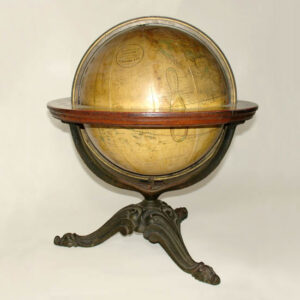Description
The map was probably based on the original 1858 pen and ink design of Frederick Law Olmsted and Calvert Vaux’s Greensward Plan for Central Park. A comparison with that drawing shows that by 1859, some paths had been added and others either eliminated or not yet constructed.
Central Park came into being beginning with an act passed on July 21, 1853 by the New York City Common Council authorizing the construction of a public park bounded by 59th and 106th Streets, Fifth and Eighth Avenues. The park was conceived to provide recreational open space for citizens of the growing city, which then had few open squares. The site that was destined to become Central Park was then “a bleak, rubbish-strewn area littered with squatters’ shacks.” (Deák) Central Park opened in 1857, and in 1858, the job of improving and expanding it, transforming the area into a pastoral oasis for the “toiling masses,” was awarded to Calvert Vaux, a young British architect, and Frederick Law Olmstead, an American farmer and magazine editor. Reconstruction began that same year and was completed in 1873.
“There was a staggering amount of work to be done to transform the area into a blend of pastoral and woodland scenery. This involved the design and construction of roadways, tunnels, bridges, arches, stairways, fountains, benches, lamp posts, gates, fences and innumerable other artifacts. It also involved the supervision of an army of about five thousand laborers…Olmsted, to whom most of the credit goes, insisted on seeing the multidimensional project as a single work of art, which he was mandated to create. For this purpose, he ventured to assume to himself the title of ‘artist.’” (Deák)
The original 1858 pen and ink drawing of the Greensward Plan on which this map was probably based is now in the collection of the New York City Department of Parks, The Arsenal. It was included in The Greatest Grid, an exhibition at the Museum of the City of New York (December 2011 through July 15, 2012) of maps documenting the development of the grid system of mapping Manhattan. The drawing is also illustrated and described in the book accompanying the exhibition. Read more about The Greatest Grid exhibition and book, or order the book here.
Albert H. Jocelyn was a New York wood engraver and electrotypist. Between 1849 and 1860, he worked in partnership with other engravers including Childs, Purcell, Whitney and Annin.
Full publication information, map: “Map of Central Park New York. Exhibiting the Drives, Promenades, Walks, Buildings, Ponds, Rocks &c. as far as finished up to July, 1859. Drawn by J.P. M’Lean. Engraved and electrotyped by A.H. Jocelyn. Entered according to Act of Congress in the year 1859, by P. Burger & Co., in the Clerk’s Office of the District Court of the United States for the Southern District of New York.”
Full publication information, guidebook: “New-York: Published by P. Burger & Co. No. 329 Greenwich Street. 1859. Entered according to Act of Congress, in the year 1859, by P. BURGER & CO., In the Clerk’s Office of the District Court of the United States for the Southern District of New-York. J. Craft, Printer 79 Ann Street. Albert H. Jocelyn, Electrotypist and Proprietor of the New York Wood Engraving Establishment, No. 60 Fulton Street.”
Inscribed in ink, inside front cover: “Presented by E.C. Bridgman 86 Warren St. N.Y. City, Feby 19th 1912.”
Condition: Map generally very good with the usual light overall toning and wear. Folds as issued with the usual slightly greater wear on the folds. Covers good, a bit toned and handled overall, the title lettering worn but legible.
References:
Ballon, Hilary, ed. The Greatest Grid: The Master Plan of Manhattan 1811-2011. New York: Museum of the City of New York and Columbia University Press, 2012. Item 99. p. 119.
Deák, Gloria Gilda. Picturing America: 1497-1899. Vol. 1. Princeton, New Jersey: Princeton University Press, 1988. pp. 535-536.
Groce, George C. and Wallace, David H. The New-York Historical Society’s Dictionary of Artists in America 1564-1860. New Haven: Yale University Press, 1969. p. 351.












